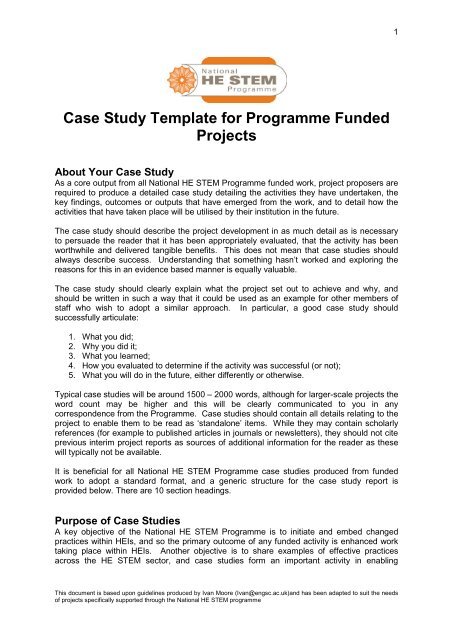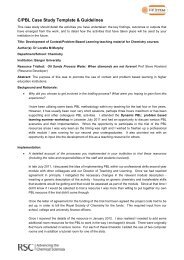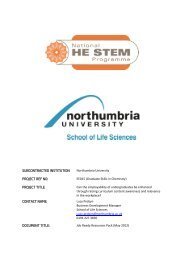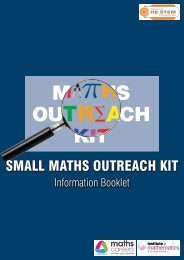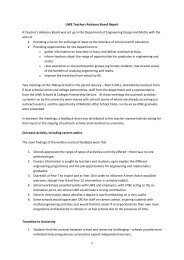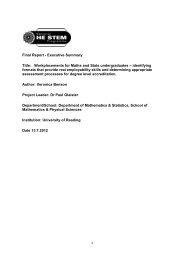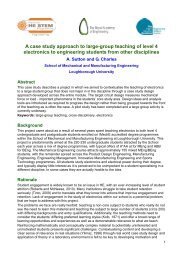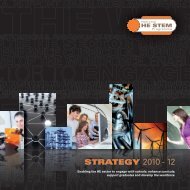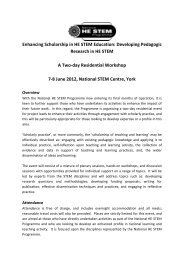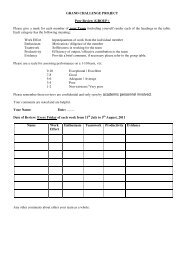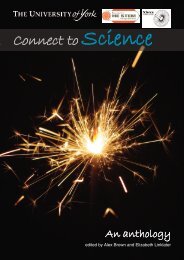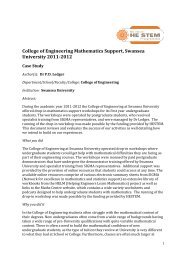Case Study Template for Programme Funded Projects - National HE ...
Case Study Template for Programme Funded Projects - National HE ...
Case Study Template for Programme Funded Projects - National HE ...
You also want an ePaper? Increase the reach of your titles
YUMPU automatically turns print PDFs into web optimized ePapers that Google loves.
1<strong>Case</strong> <strong>Study</strong> <strong>Template</strong> <strong>for</strong> <strong>Programme</strong> <strong>Funded</strong><strong>Projects</strong>About Your <strong>Case</strong> <strong>Study</strong>As a core output from all <strong>National</strong> <strong>HE</strong> STEM <strong>Programme</strong> funded work, project proposers arerequired to produce a detailed case study detailing the activities they have undertaken, thekey findings, outcomes or outputs that have emerged from the work, and to detail how theactivities that have taken place will be utilised by their institution in the future.The case study should describe the project development in as much detail as is necessaryto persuade the reader that it has been appropriately evaluated, that the activity has beenworthwhile and delivered tangible benefits. This does not mean that case studies shouldalways describe success. Understanding that something hasn’t worked and exploring thereasons <strong>for</strong> this in an evidence based manner is equally valuable.The case study should clearly explain what the project set out to achieve and why, andshould be written in such a way that it could be used as an example <strong>for</strong> other members ofstaff who wish to adopt a similar approach. In particular, a good case study shouldsuccessfully articulate:1. What you did;2. Why you did it;3. What you learned;4. How you evaluated to determine if the activity was successful (or not);5. What you will do in the future, either differently or otherwise.Typical case studies will be around 1500 – 2000 words, although <strong>for</strong> larger-scale projects theword count may be higher and this will be clearly communicated to you in anycorrespondence from the <strong>Programme</strong>. <strong>Case</strong> studies should contain all details relating to theproject to enable them to be read as ‘standalone’ items. While they may contain scholarlyreferences (<strong>for</strong> example to published articles in journals or newsletters), they should not citeprevious interim project reports as sources of additional in<strong>for</strong>mation <strong>for</strong> the reader as thesewill typically not be available.It is beneficial <strong>for</strong> all <strong>National</strong> <strong>HE</strong> STEM <strong>Programme</strong> case studies produced from fundedwork to adopt a standard <strong>for</strong>mat, and a generic structure <strong>for</strong> the case study report isprovided below. There are 10 section headings.Purpose of <strong>Case</strong> StudiesA key objective of the <strong>National</strong> <strong>HE</strong> STEM <strong>Programme</strong> is to initiate and embed changedpractices within <strong>HE</strong>Is, and so the primary outcome of any funded activity is enhanced worktaking place within <strong>HE</strong>Is. Another objective is to share examples of effective practicesacross the <strong>HE</strong> STEM sector, and case studies <strong>for</strong>m an important activity in enablingThis document is based upon guidelines produced by Ivan Moore (Ivan@engsc.ac.uk)and has been adapted to suit the needsof projects specifically supported through the <strong>National</strong> <strong>HE</strong> STEM programme
2fulfilment of this objective. All <strong>Programme</strong> funded activities are there<strong>for</strong>e required to providea case study detailing the experience and learning gained from the work undertaken.<strong>Case</strong> studies submitted from all <strong>National</strong> <strong>HE</strong> STEM <strong>Programme</strong> funded projects will bereviewed by representatives from the <strong>National</strong> <strong>HE</strong> STEM <strong>Programme</strong>. Feedback will beprovided, and representatives of the programme may work with you to revise the case studyto maximise its potential impact within the <strong>HE</strong> STEM sector. Accepted case studies willsubsequently be <strong>for</strong>matted and made available online. Select case studies may also beidentified <strong>for</strong> inclusion within a dedicated volume of work that will be made available in bothprinted and electronic <strong>for</strong>ms.The publications produced by the <strong>Programme</strong> are intended to be high-profile, and will bedisseminated at national conferences and events. Publication is there<strong>for</strong>e intended to beprestigious and it is expected candidates will be able to cite publication as a means ofcontributing towards career enhancement. In addition, with funding becoming scarce acrossthe entire education sector, case studies provide an effective means of not onlycommunicating the impact a project has had or its potential <strong>for</strong> further funded development,but also to articulate the expertise of those involved in undertaking the work.<strong>Case</strong> <strong>Study</strong> StructureTitle:Author(s):Department/School:Institution:Abstract: This should give an overview of the project, including the key objectives andoutcomes. It should highlight particular successes and any key learning that has emerged.The abstract should not exceed 200 words.Background and Rationale:This should provide context to the activity taking place. It should briefly outline the work thathas taken place, and give an explanation of why the practice was initiated or necessary. Ifappropriate, a brief explanation of previous practice should also be included.It should outline why the proposed curriculum change or work is necessary, and mayinclude, if relevant, reference to appropriate pedagogic literature or wider examples ofevaluated practice to justify or explain the work taking place.Implementation: This is the main section of the case study and so you should provide asmuch detail as possible. The in<strong>for</strong>mation should be sufficient <strong>for</strong> a reader to not onlyunderstand what has taken place, but to provide a level of detail to enable them to adopt oradapt this approach within their institutions. This might include:• A detailed account of the approach (including role and responsibilities of staff andany students involved in the activity) used.• The changes that have taken place as a result of the activity. These might bereferenced against what you intended to do as part of the work.• A summary of how the activity was not only developed but also how it was delivered;This document is based upon guidelines produced by Ivan Moore (Ivan@engsc.ac.uk)and has been adapted to suit the needsof projects specifically supported through the <strong>National</strong> <strong>HE</strong> STEM programme
3• How appropriate quality assurance mechanisms were incorporated to ensure qualityof delivery.Evaluation: Evaluation tends to be the weakest part of case studies and readers are oftenleft to make their own judgments, which are often subjective, and so there is a need toensure this is done with appropriate rigour. Evaluation is particularly important <strong>for</strong> obtainingevidence based data to support any applications you might make <strong>for</strong> developing your workfurther in the future. The discussion around your evaluation may include the following:• Your approach to evaluation (purpose and objectives);• The evaluation methods (including <strong>for</strong>m of analysis) utilised;• A synthesis from the captured data including response rates and sample sizes.Throughout the <strong>Programme</strong>, the <strong>Programme</strong>’s External Evaluators consulting in place will becontacting those undertaking <strong>Programme</strong> funded activities. The purpose of this is to assistwith the overall evaluation of the <strong>Programme</strong> in terms of identifying impact and the value thatthe activities have offered to the wider <strong>HE</strong> STEM sector. The findings from this work willalso assist with the development of individual case studies from projects.Discussion, Learning and Impact (Success): This section is another substantial section ofthe case study. It should start by outlining the outcomes, key findings and analyses of theevaluation. It contains details of how the practice is known to be successful. In particular,there is a need to see examples of successful evaluation, student feedback, and ifappropriate, evidence of wider impact, possibly beyond the original <strong>HE</strong>I involved. Thissection should also clearly describe what has changed within the <strong>HE</strong>I or within individualfuture practice as a result of the activity.It should also seek to articulate:• Whether the goals/intended outcomes at the start of the work were successfullyachieved;• Was the approach successful and why?• What the key lessons are that were learned from the work;• What was effective or beneficial about the work with particular attention given toimpact on the target audience (i.e. those who the activity was originally aimed at?• What would you do differently if you were undertake the activity again (and why), andwhat advice would you give to others wishing to undertake similar work?• Barriers and enablers: What were the key threshold points that made implementingthe activity difficult (barriers), and how were these subsequently overcome(enablers).Further Development and Sustainability: This section should detail ideas <strong>for</strong> how youpropose to develop or modify the activity in future years in response to your experience andfindings. As an absolute minimum, it must detail how you intend to build upon the learningfrom the work; this might include:• How the project will be sustained so that its activities continue in future years;• How you will expand and/or transferring practices to other modules, courses,programmes of study, across the faculties or departments within your institution, ormore widely across the <strong>HE</strong> sector.This document is based upon guidelines produced by Ivan Moore (Ivan@engsc.ac.uk)and has been adapted to suit the needsof projects specifically supported through the <strong>National</strong> <strong>HE</strong> STEM programme
4Outputs: This section should contain a list of all the outputs that have emerged from yourwork. These must be made available to the <strong>National</strong> <strong>HE</strong> STEM <strong>Programme</strong>, and inelectronic versions of your case studies, these outputs will be hyperlinked.If you have any images, illustrations or quotes that you feel will support your case study,then you are encouraged to submit these also. This will particularly enhance thepresentation of both online and printed case studies.References: Appropriate references should be included, although <strong>for</strong> 1500 – 2000 wordcase studies they should not exceed 5 -10 items. References should be presented instandard Harvard <strong>for</strong>mat 1 .1 For example see: http://libweb.anglia.ac.uk/referencing/harvard.htmThis document is based upon guidelines produced by Ivan Moore (Ivan@engsc.ac.uk)and has been adapted to suit the needsof projects specifically supported through the <strong>National</strong> <strong>HE</strong> STEM programme


